Critical Analysis of Organizational Development Theories and Practices
VerifiedAdded on 2020/03/16
|8
|2927
|49
Essay
AI Summary
This essay provides a critical analysis of strategic choice and deterministic theories within the context of organizational development. It begins by examining strategic choice theory, emphasizing its role in shaping organizational actions and fostering employer-employee relations, especially in response to external market dynamics. The essay then delves into deterministic theories, exploring resource dependency, institutional theory, and population ecology. Resource dependency focuses on the importance of managing resources effectively. Institutional theory emphasizes the significance of internal structure and culture. Population ecology analyzes organizational adaptation and selection within its environment. The essay concludes by arguing that deterministic theory offers the most comprehensive framework for organizational development, integrating the strengths of strategic choice and providing a broader scope for implementing effective management practices, resource management, and environmental adaptation, ultimately leading to improved organizational performance and employee engagement.
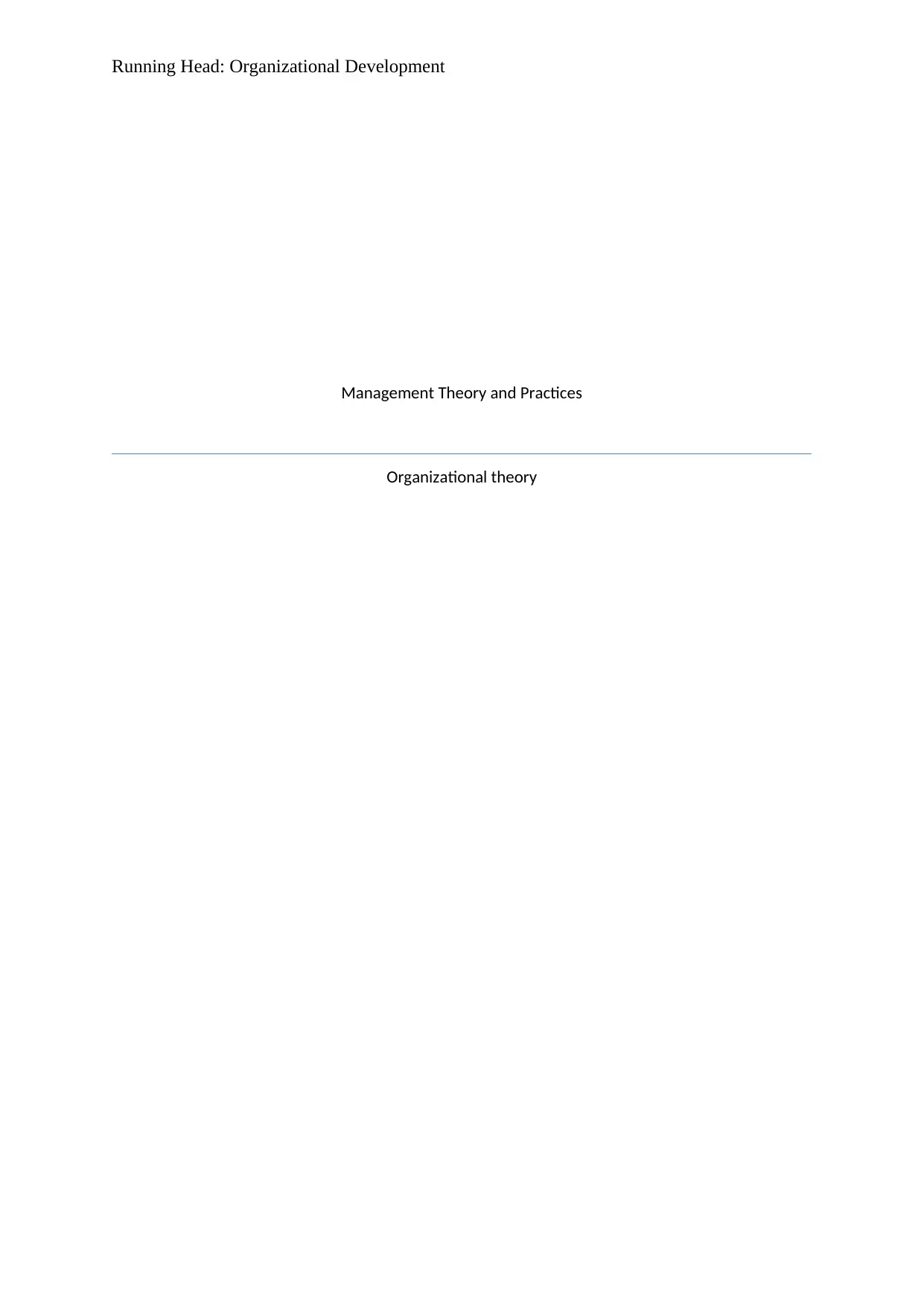
Running Head: Organizational Development
Management Theory and Practices
Organizational theory
Management Theory and Practices
Organizational theory
Paraphrase This Document
Need a fresh take? Get an instant paraphrase of this document with our AI Paraphraser
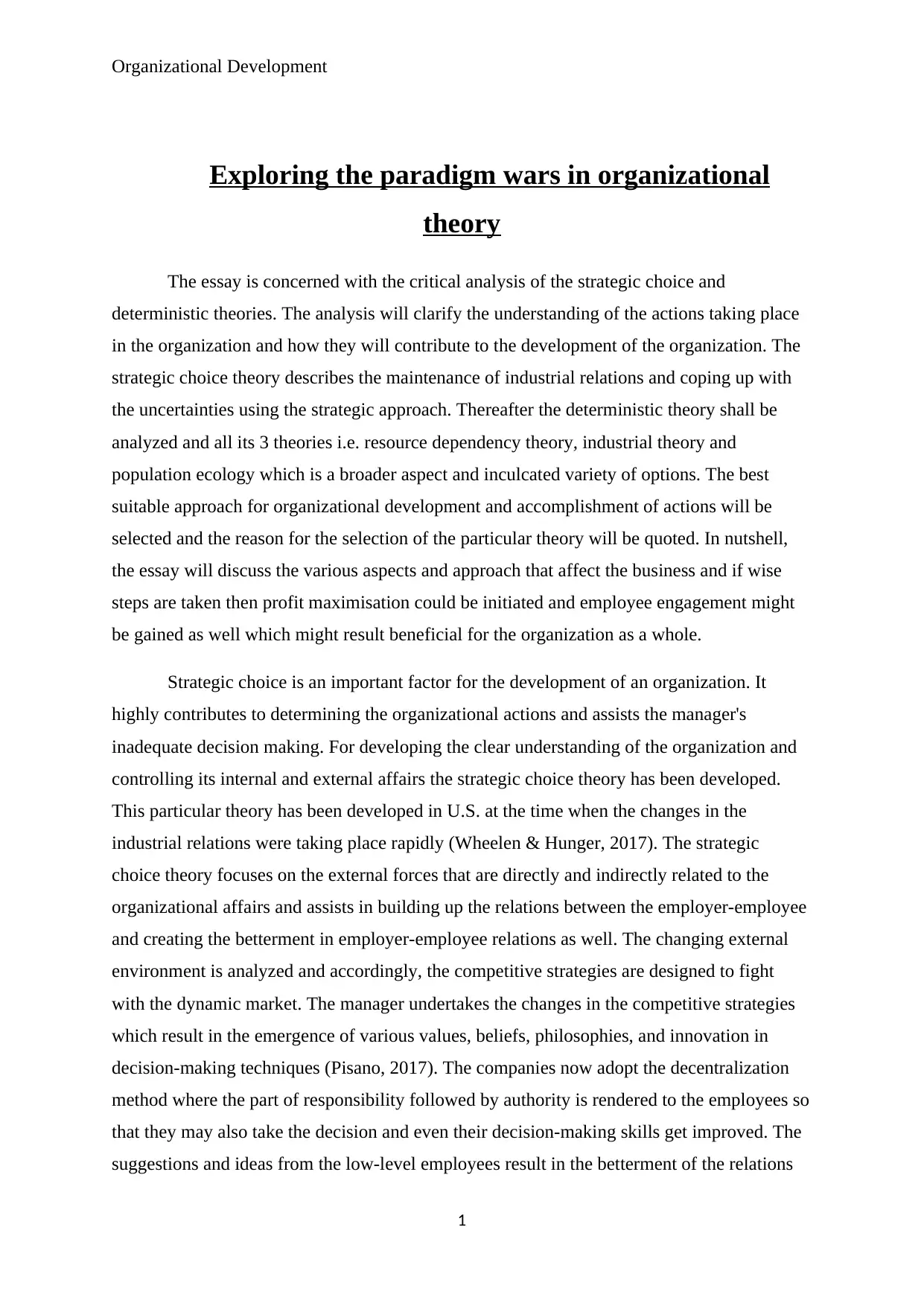
Organizational Development
Exploring the paradigm wars in organizational
theory
The essay is concerned with the critical analysis of the strategic choice and
deterministic theories. The analysis will clarify the understanding of the actions taking place
in the organization and how they will contribute to the development of the organization. The
strategic choice theory describes the maintenance of industrial relations and coping up with
the uncertainties using the strategic approach. Thereafter the deterministic theory shall be
analyzed and all its 3 theories i.e. resource dependency theory, industrial theory and
population ecology which is a broader aspect and inculcated variety of options. The best
suitable approach for organizational development and accomplishment of actions will be
selected and the reason for the selection of the particular theory will be quoted. In nutshell,
the essay will discuss the various aspects and approach that affect the business and if wise
steps are taken then profit maximisation could be initiated and employee engagement might
be gained as well which might result beneficial for the organization as a whole.
Strategic choice is an important factor for the development of an organization. It
highly contributes to determining the organizational actions and assists the manager's
inadequate decision making. For developing the clear understanding of the organization and
controlling its internal and external affairs the strategic choice theory has been developed.
This particular theory has been developed in U.S. at the time when the changes in the
industrial relations were taking place rapidly (Wheelen & Hunger, 2017). The strategic
choice theory focuses on the external forces that are directly and indirectly related to the
organizational affairs and assists in building up the relations between the employer-employee
and creating the betterment in employer-employee relations as well. The changing external
environment is analyzed and accordingly, the competitive strategies are designed to fight
with the dynamic market. The manager undertakes the changes in the competitive strategies
which result in the emergence of various values, beliefs, philosophies, and innovation in
decision-making techniques (Pisano, 2017). The companies now adopt the decentralization
method where the part of responsibility followed by authority is rendered to the employees so
that they may also take the decision and even their decision-making skills get improved. The
suggestions and ideas from the low-level employees result in the betterment of the relations
1
Exploring the paradigm wars in organizational
theory
The essay is concerned with the critical analysis of the strategic choice and
deterministic theories. The analysis will clarify the understanding of the actions taking place
in the organization and how they will contribute to the development of the organization. The
strategic choice theory describes the maintenance of industrial relations and coping up with
the uncertainties using the strategic approach. Thereafter the deterministic theory shall be
analyzed and all its 3 theories i.e. resource dependency theory, industrial theory and
population ecology which is a broader aspect and inculcated variety of options. The best
suitable approach for organizational development and accomplishment of actions will be
selected and the reason for the selection of the particular theory will be quoted. In nutshell,
the essay will discuss the various aspects and approach that affect the business and if wise
steps are taken then profit maximisation could be initiated and employee engagement might
be gained as well which might result beneficial for the organization as a whole.
Strategic choice is an important factor for the development of an organization. It
highly contributes to determining the organizational actions and assists the manager's
inadequate decision making. For developing the clear understanding of the organization and
controlling its internal and external affairs the strategic choice theory has been developed.
This particular theory has been developed in U.S. at the time when the changes in the
industrial relations were taking place rapidly (Wheelen & Hunger, 2017). The strategic
choice theory focuses on the external forces that are directly and indirectly related to the
organizational affairs and assists in building up the relations between the employer-employee
and creating the betterment in employer-employee relations as well. The changing external
environment is analyzed and accordingly, the competitive strategies are designed to fight
with the dynamic market. The manager undertakes the changes in the competitive strategies
which result in the emergence of various values, beliefs, philosophies, and innovation in
decision-making techniques (Pisano, 2017). The companies now adopt the decentralization
method where the part of responsibility followed by authority is rendered to the employees so
that they may also take the decision and even their decision-making skills get improved. The
suggestions and ideas from the low-level employees result in the betterment of the relations
1
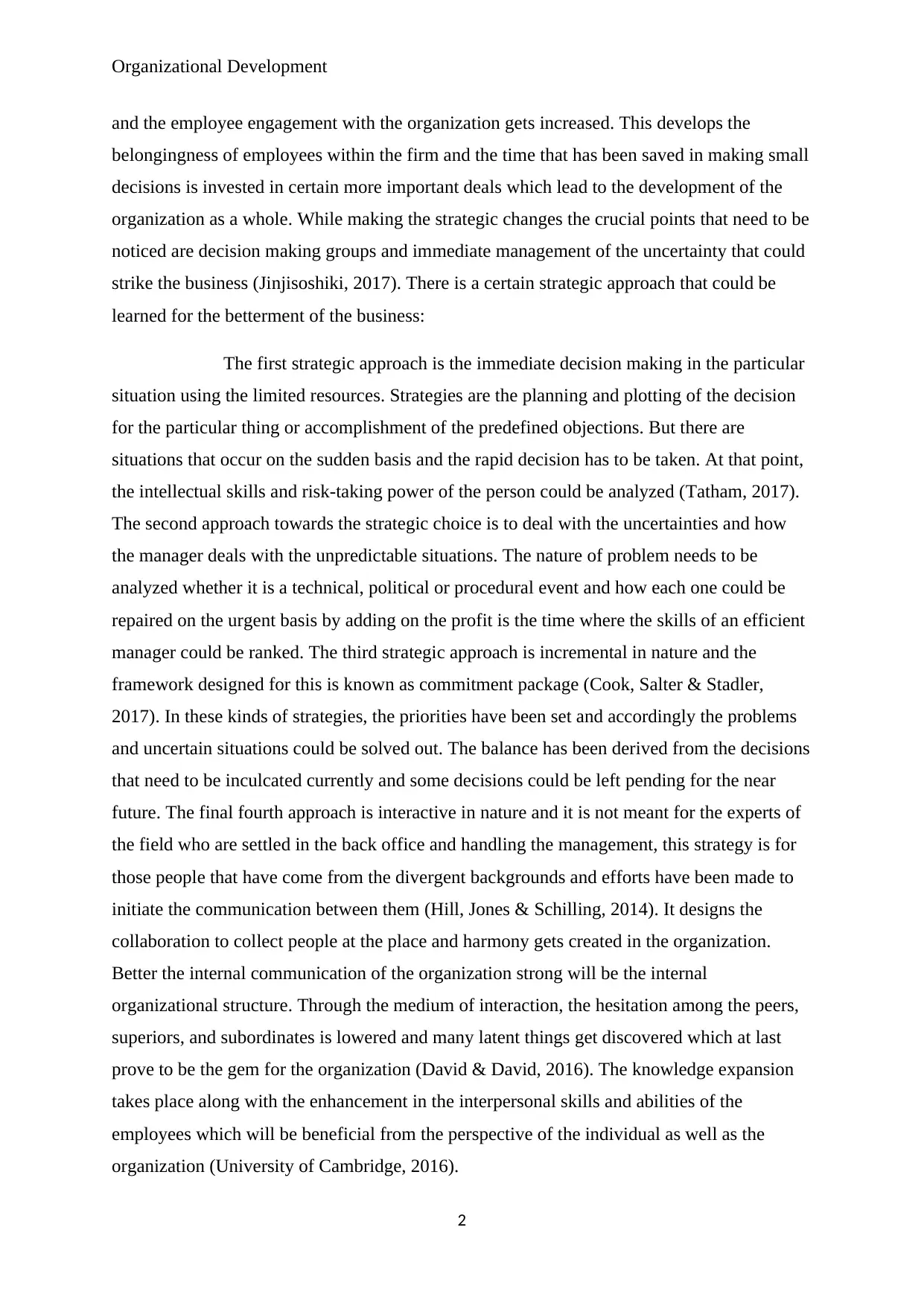
Organizational Development
and the employee engagement with the organization gets increased. This develops the
belongingness of employees within the firm and the time that has been saved in making small
decisions is invested in certain more important deals which lead to the development of the
organization as a whole. While making the strategic changes the crucial points that need to be
noticed are decision making groups and immediate management of the uncertainty that could
strike the business (Jinjisoshiki, 2017). There is a certain strategic approach that could be
learned for the betterment of the business:
The first strategic approach is the immediate decision making in the particular
situation using the limited resources. Strategies are the planning and plotting of the decision
for the particular thing or accomplishment of the predefined objections. But there are
situations that occur on the sudden basis and the rapid decision has to be taken. At that point,
the intellectual skills and risk-taking power of the person could be analyzed (Tatham, 2017).
The second approach towards the strategic choice is to deal with the uncertainties and how
the manager deals with the unpredictable situations. The nature of problem needs to be
analyzed whether it is a technical, political or procedural event and how each one could be
repaired on the urgent basis by adding on the profit is the time where the skills of an efficient
manager could be ranked. The third strategic approach is incremental in nature and the
framework designed for this is known as commitment package (Cook, Salter & Stadler,
2017). In these kinds of strategies, the priorities have been set and accordingly the problems
and uncertain situations could be solved out. The balance has been derived from the decisions
that need to be inculcated currently and some decisions could be left pending for the near
future. The final fourth approach is interactive in nature and it is not meant for the experts of
the field who are settled in the back office and handling the management, this strategy is for
those people that have come from the divergent backgrounds and efforts have been made to
initiate the communication between them (Hill, Jones & Schilling, 2014). It designs the
collaboration to collect people at the place and harmony gets created in the organization.
Better the internal communication of the organization strong will be the internal
organizational structure. Through the medium of interaction, the hesitation among the peers,
superiors, and subordinates is lowered and many latent things get discovered which at last
prove to be the gem for the organization (David & David, 2016). The knowledge expansion
takes place along with the enhancement in the interpersonal skills and abilities of the
employees which will be beneficial from the perspective of the individual as well as the
organization (University of Cambridge, 2016).
2
and the employee engagement with the organization gets increased. This develops the
belongingness of employees within the firm and the time that has been saved in making small
decisions is invested in certain more important deals which lead to the development of the
organization as a whole. While making the strategic changes the crucial points that need to be
noticed are decision making groups and immediate management of the uncertainty that could
strike the business (Jinjisoshiki, 2017). There is a certain strategic approach that could be
learned for the betterment of the business:
The first strategic approach is the immediate decision making in the particular
situation using the limited resources. Strategies are the planning and plotting of the decision
for the particular thing or accomplishment of the predefined objections. But there are
situations that occur on the sudden basis and the rapid decision has to be taken. At that point,
the intellectual skills and risk-taking power of the person could be analyzed (Tatham, 2017).
The second approach towards the strategic choice is to deal with the uncertainties and how
the manager deals with the unpredictable situations. The nature of problem needs to be
analyzed whether it is a technical, political or procedural event and how each one could be
repaired on the urgent basis by adding on the profit is the time where the skills of an efficient
manager could be ranked. The third strategic approach is incremental in nature and the
framework designed for this is known as commitment package (Cook, Salter & Stadler,
2017). In these kinds of strategies, the priorities have been set and accordingly the problems
and uncertain situations could be solved out. The balance has been derived from the decisions
that need to be inculcated currently and some decisions could be left pending for the near
future. The final fourth approach is interactive in nature and it is not meant for the experts of
the field who are settled in the back office and handling the management, this strategy is for
those people that have come from the divergent backgrounds and efforts have been made to
initiate the communication between them (Hill, Jones & Schilling, 2014). It designs the
collaboration to collect people at the place and harmony gets created in the organization.
Better the internal communication of the organization strong will be the internal
organizational structure. Through the medium of interaction, the hesitation among the peers,
superiors, and subordinates is lowered and many latent things get discovered which at last
prove to be the gem for the organization (David & David, 2016). The knowledge expansion
takes place along with the enhancement in the interpersonal skills and abilities of the
employees which will be beneficial from the perspective of the individual as well as the
organization (University of Cambridge, 2016).
2
⊘ This is a preview!⊘
Do you want full access?
Subscribe today to unlock all pages.

Trusted by 1+ million students worldwide
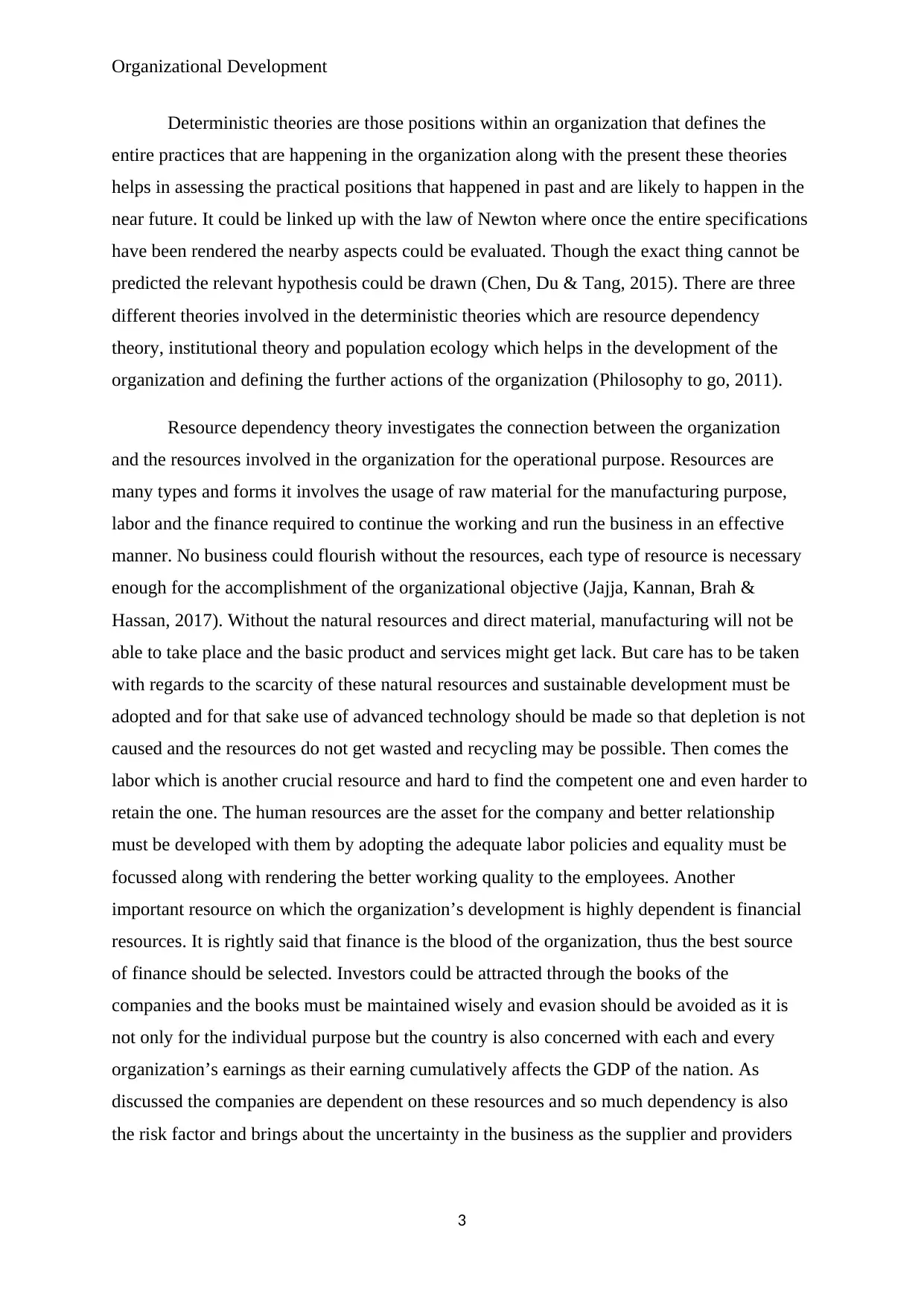
Organizational Development
Deterministic theories are those positions within an organization that defines the
entire practices that are happening in the organization along with the present these theories
helps in assessing the practical positions that happened in past and are likely to happen in the
near future. It could be linked up with the law of Newton where once the entire specifications
have been rendered the nearby aspects could be evaluated. Though the exact thing cannot be
predicted the relevant hypothesis could be drawn (Chen, Du & Tang, 2015). There are three
different theories involved in the deterministic theories which are resource dependency
theory, institutional theory and population ecology which helps in the development of the
organization and defining the further actions of the organization (Philosophy to go, 2011).
Resource dependency theory investigates the connection between the organization
and the resources involved in the organization for the operational purpose. Resources are
many types and forms it involves the usage of raw material for the manufacturing purpose,
labor and the finance required to continue the working and run the business in an effective
manner. No business could flourish without the resources, each type of resource is necessary
enough for the accomplishment of the organizational objective (Jajja, Kannan, Brah &
Hassan, 2017). Without the natural resources and direct material, manufacturing will not be
able to take place and the basic product and services might get lack. But care has to be taken
with regards to the scarcity of these natural resources and sustainable development must be
adopted and for that sake use of advanced technology should be made so that depletion is not
caused and the resources do not get wasted and recycling may be possible. Then comes the
labor which is another crucial resource and hard to find the competent one and even harder to
retain the one. The human resources are the asset for the company and better relationship
must be developed with them by adopting the adequate labor policies and equality must be
focussed along with rendering the better working quality to the employees. Another
important resource on which the organization’s development is highly dependent is financial
resources. It is rightly said that finance is the blood of the organization, thus the best source
of finance should be selected. Investors could be attracted through the books of the
companies and the books must be maintained wisely and evasion should be avoided as it is
not only for the individual purpose but the country is also concerned with each and every
organization’s earnings as their earning cumulatively affects the GDP of the nation. As
discussed the companies are dependent on these resources and so much dependency is also
the risk factor and brings about the uncertainty in the business as the supplier and providers
3
Deterministic theories are those positions within an organization that defines the
entire practices that are happening in the organization along with the present these theories
helps in assessing the practical positions that happened in past and are likely to happen in the
near future. It could be linked up with the law of Newton where once the entire specifications
have been rendered the nearby aspects could be evaluated. Though the exact thing cannot be
predicted the relevant hypothesis could be drawn (Chen, Du & Tang, 2015). There are three
different theories involved in the deterministic theories which are resource dependency
theory, institutional theory and population ecology which helps in the development of the
organization and defining the further actions of the organization (Philosophy to go, 2011).
Resource dependency theory investigates the connection between the organization
and the resources involved in the organization for the operational purpose. Resources are
many types and forms it involves the usage of raw material for the manufacturing purpose,
labor and the finance required to continue the working and run the business in an effective
manner. No business could flourish without the resources, each type of resource is necessary
enough for the accomplishment of the organizational objective (Jajja, Kannan, Brah &
Hassan, 2017). Without the natural resources and direct material, manufacturing will not be
able to take place and the basic product and services might get lack. But care has to be taken
with regards to the scarcity of these natural resources and sustainable development must be
adopted and for that sake use of advanced technology should be made so that depletion is not
caused and the resources do not get wasted and recycling may be possible. Then comes the
labor which is another crucial resource and hard to find the competent one and even harder to
retain the one. The human resources are the asset for the company and better relationship
must be developed with them by adopting the adequate labor policies and equality must be
focussed along with rendering the better working quality to the employees. Another
important resource on which the organization’s development is highly dependent is financial
resources. It is rightly said that finance is the blood of the organization, thus the best source
of finance should be selected. Investors could be attracted through the books of the
companies and the books must be maintained wisely and evasion should be avoided as it is
not only for the individual purpose but the country is also concerned with each and every
organization’s earnings as their earning cumulatively affects the GDP of the nation. As
discussed the companies are dependent on these resources and so much dependency is also
the risk factor and brings about the uncertainty in the business as the supplier and providers
3
Paraphrase This Document
Need a fresh take? Get an instant paraphrase of this document with our AI Paraphraser
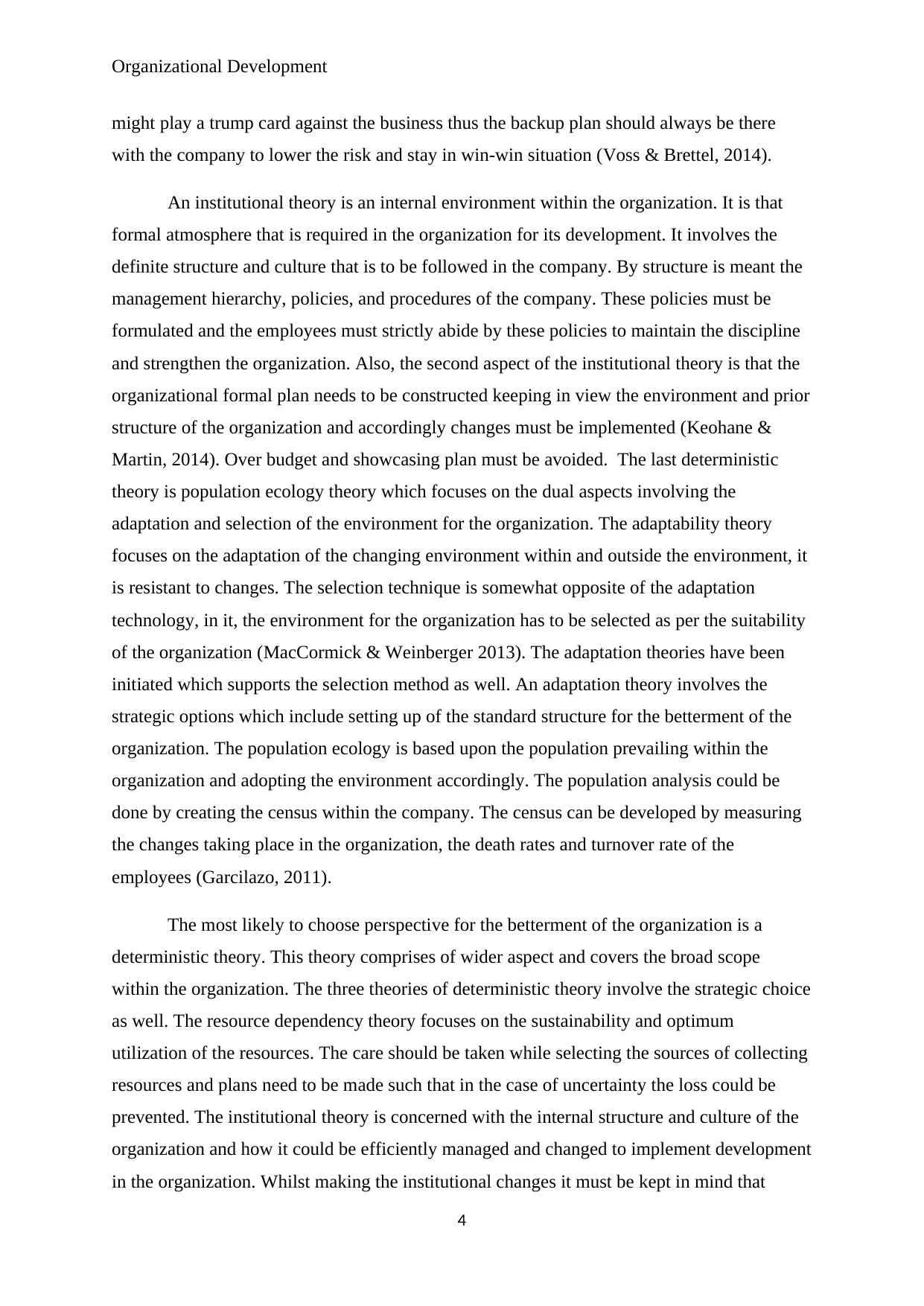
Organizational Development
might play a trump card against the business thus the backup plan should always be there
with the company to lower the risk and stay in win-win situation (Voss & Brettel, 2014).
An institutional theory is an internal environment within the organization. It is that
formal atmosphere that is required in the organization for its development. It involves the
definite structure and culture that is to be followed in the company. By structure is meant the
management hierarchy, policies, and procedures of the company. These policies must be
formulated and the employees must strictly abide by these policies to maintain the discipline
and strengthen the organization. Also, the second aspect of the institutional theory is that the
organizational formal plan needs to be constructed keeping in view the environment and prior
structure of the organization and accordingly changes must be implemented (Keohane &
Martin, 2014). Over budget and showcasing plan must be avoided. The last deterministic
theory is population ecology theory which focuses on the dual aspects involving the
adaptation and selection of the environment for the organization. The adaptability theory
focuses on the adaptation of the changing environment within and outside the environment, it
is resistant to changes. The selection technique is somewhat opposite of the adaptation
technology, in it, the environment for the organization has to be selected as per the suitability
of the organization (MacCormick & Weinberger 2013). The adaptation theories have been
initiated which supports the selection method as well. An adaptation theory involves the
strategic options which include setting up of the standard structure for the betterment of the
organization. The population ecology is based upon the population prevailing within the
organization and adopting the environment accordingly. The population analysis could be
done by creating the census within the company. The census can be developed by measuring
the changes taking place in the organization, the death rates and turnover rate of the
employees (Garcilazo, 2011).
The most likely to choose perspective for the betterment of the organization is a
deterministic theory. This theory comprises of wider aspect and covers the broad scope
within the organization. The three theories of deterministic theory involve the strategic choice
as well. The resource dependency theory focuses on the sustainability and optimum
utilization of the resources. The care should be taken while selecting the sources of collecting
resources and plans need to be made such that in the case of uncertainty the loss could be
prevented. The institutional theory is concerned with the internal structure and culture of the
organization and how it could be efficiently managed and changed to implement development
in the organization. Whilst making the institutional changes it must be kept in mind that
4
might play a trump card against the business thus the backup plan should always be there
with the company to lower the risk and stay in win-win situation (Voss & Brettel, 2014).
An institutional theory is an internal environment within the organization. It is that
formal atmosphere that is required in the organization for its development. It involves the
definite structure and culture that is to be followed in the company. By structure is meant the
management hierarchy, policies, and procedures of the company. These policies must be
formulated and the employees must strictly abide by these policies to maintain the discipline
and strengthen the organization. Also, the second aspect of the institutional theory is that the
organizational formal plan needs to be constructed keeping in view the environment and prior
structure of the organization and accordingly changes must be implemented (Keohane &
Martin, 2014). Over budget and showcasing plan must be avoided. The last deterministic
theory is population ecology theory which focuses on the dual aspects involving the
adaptation and selection of the environment for the organization. The adaptability theory
focuses on the adaptation of the changing environment within and outside the environment, it
is resistant to changes. The selection technique is somewhat opposite of the adaptation
technology, in it, the environment for the organization has to be selected as per the suitability
of the organization (MacCormick & Weinberger 2013). The adaptation theories have been
initiated which supports the selection method as well. An adaptation theory involves the
strategic options which include setting up of the standard structure for the betterment of the
organization. The population ecology is based upon the population prevailing within the
organization and adopting the environment accordingly. The population analysis could be
done by creating the census within the company. The census can be developed by measuring
the changes taking place in the organization, the death rates and turnover rate of the
employees (Garcilazo, 2011).
The most likely to choose perspective for the betterment of the organization is a
deterministic theory. This theory comprises of wider aspect and covers the broad scope
within the organization. The three theories of deterministic theory involve the strategic choice
as well. The resource dependency theory focuses on the sustainability and optimum
utilization of the resources. The care should be taken while selecting the sources of collecting
resources and plans need to be made such that in the case of uncertainty the loss could be
prevented. The institutional theory is concerned with the internal structure and culture of the
organization and how it could be efficiently managed and changed to implement development
in the organization. Whilst making the institutional changes it must be kept in mind that
4
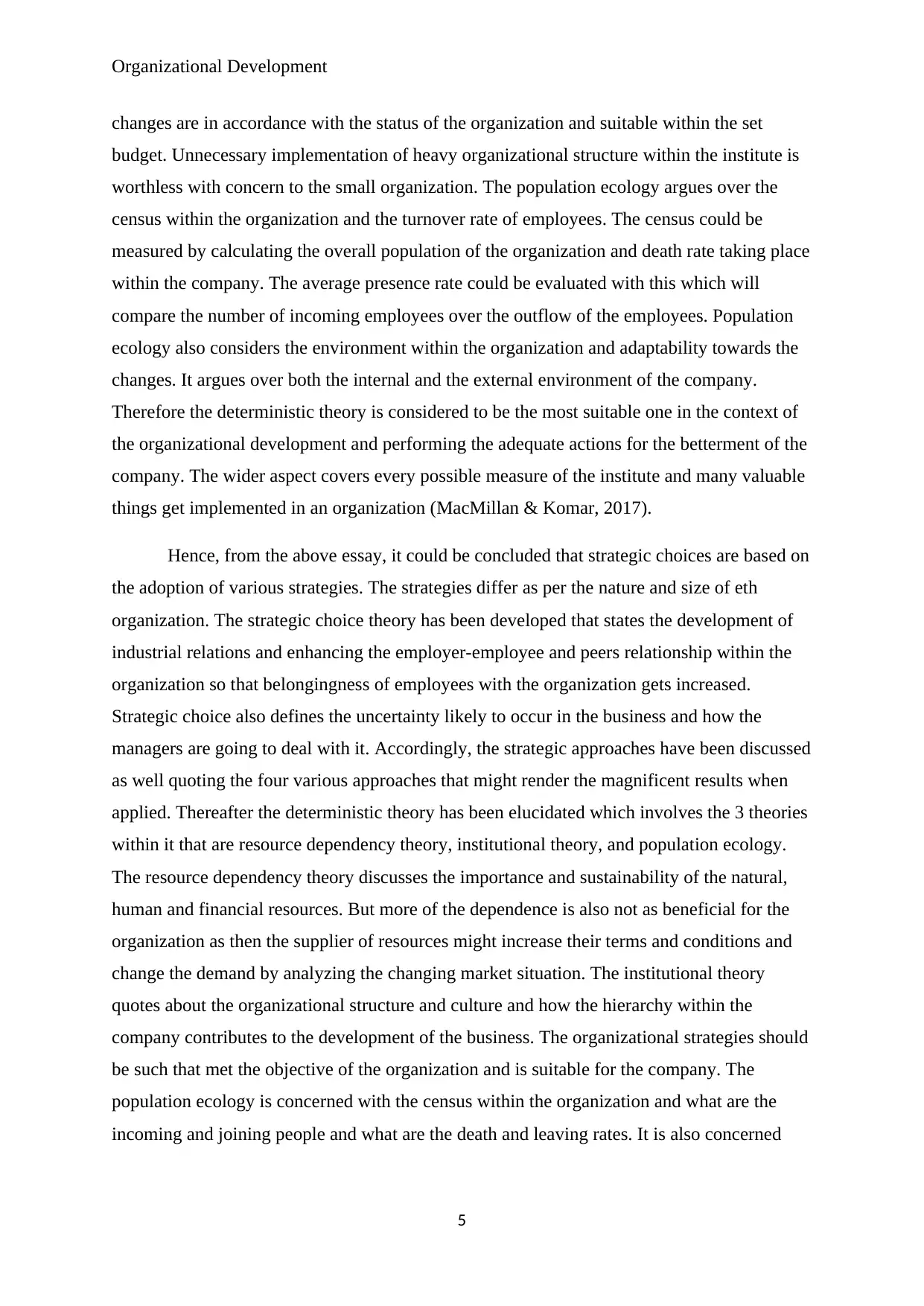
Organizational Development
changes are in accordance with the status of the organization and suitable within the set
budget. Unnecessary implementation of heavy organizational structure within the institute is
worthless with concern to the small organization. The population ecology argues over the
census within the organization and the turnover rate of employees. The census could be
measured by calculating the overall population of the organization and death rate taking place
within the company. The average presence rate could be evaluated with this which will
compare the number of incoming employees over the outflow of the employees. Population
ecology also considers the environment within the organization and adaptability towards the
changes. It argues over both the internal and the external environment of the company.
Therefore the deterministic theory is considered to be the most suitable one in the context of
the organizational development and performing the adequate actions for the betterment of the
company. The wider aspect covers every possible measure of the institute and many valuable
things get implemented in an organization (MacMillan & Komar, 2017).
Hence, from the above essay, it could be concluded that strategic choices are based on
the adoption of various strategies. The strategies differ as per the nature and size of eth
organization. The strategic choice theory has been developed that states the development of
industrial relations and enhancing the employer-employee and peers relationship within the
organization so that belongingness of employees with the organization gets increased.
Strategic choice also defines the uncertainty likely to occur in the business and how the
managers are going to deal with it. Accordingly, the strategic approaches have been discussed
as well quoting the four various approaches that might render the magnificent results when
applied. Thereafter the deterministic theory has been elucidated which involves the 3 theories
within it that are resource dependency theory, institutional theory, and population ecology.
The resource dependency theory discusses the importance and sustainability of the natural,
human and financial resources. But more of the dependence is also not as beneficial for the
organization as then the supplier of resources might increase their terms and conditions and
change the demand by analyzing the changing market situation. The institutional theory
quotes about the organizational structure and culture and how the hierarchy within the
company contributes to the development of the business. The organizational strategies should
be such that met the objective of the organization and is suitable for the company. The
population ecology is concerned with the census within the organization and what are the
incoming and joining people and what are the death and leaving rates. It is also concerned
5
changes are in accordance with the status of the organization and suitable within the set
budget. Unnecessary implementation of heavy organizational structure within the institute is
worthless with concern to the small organization. The population ecology argues over the
census within the organization and the turnover rate of employees. The census could be
measured by calculating the overall population of the organization and death rate taking place
within the company. The average presence rate could be evaluated with this which will
compare the number of incoming employees over the outflow of the employees. Population
ecology also considers the environment within the organization and adaptability towards the
changes. It argues over both the internal and the external environment of the company.
Therefore the deterministic theory is considered to be the most suitable one in the context of
the organizational development and performing the adequate actions for the betterment of the
company. The wider aspect covers every possible measure of the institute and many valuable
things get implemented in an organization (MacMillan & Komar, 2017).
Hence, from the above essay, it could be concluded that strategic choices are based on
the adoption of various strategies. The strategies differ as per the nature and size of eth
organization. The strategic choice theory has been developed that states the development of
industrial relations and enhancing the employer-employee and peers relationship within the
organization so that belongingness of employees with the organization gets increased.
Strategic choice also defines the uncertainty likely to occur in the business and how the
managers are going to deal with it. Accordingly, the strategic approaches have been discussed
as well quoting the four various approaches that might render the magnificent results when
applied. Thereafter the deterministic theory has been elucidated which involves the 3 theories
within it that are resource dependency theory, institutional theory, and population ecology.
The resource dependency theory discusses the importance and sustainability of the natural,
human and financial resources. But more of the dependence is also not as beneficial for the
organization as then the supplier of resources might increase their terms and conditions and
change the demand by analyzing the changing market situation. The institutional theory
quotes about the organizational structure and culture and how the hierarchy within the
company contributes to the development of the business. The organizational strategies should
be such that met the objective of the organization and is suitable for the company. The
population ecology is concerned with the census within the organization and what are the
incoming and joining people and what are the death and leaving rates. It is also concerned
5
⊘ This is a preview!⊘
Do you want full access?
Subscribe today to unlock all pages.

Trusted by 1+ million students worldwide
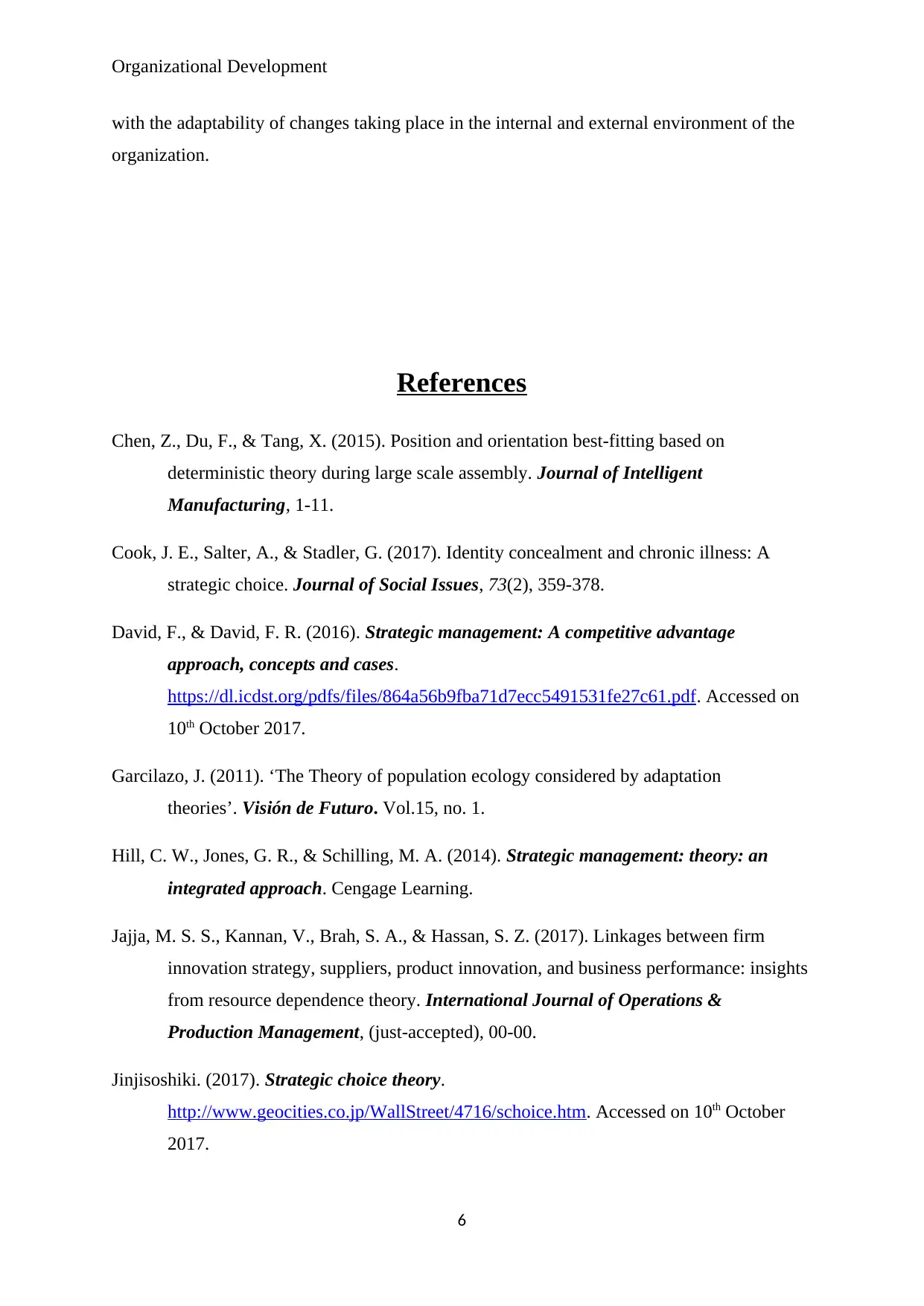
Organizational Development
with the adaptability of changes taking place in the internal and external environment of the
organization.
References
Chen, Z., Du, F., & Tang, X. (2015). Position and orientation best-fitting based on
deterministic theory during large scale assembly. Journal of Intelligent
Manufacturing, 1-11.
Cook, J. E., Salter, A., & Stadler, G. (2017). Identity concealment and chronic illness: A
strategic choice. Journal of Social Issues, 73(2), 359-378.
David, F., & David, F. R. (2016). Strategic management: A competitive advantage
approach, concepts and cases.
https://dl.icdst.org/pdfs/files/864a56b9fba71d7ecc5491531fe27c61.pdf. Accessed on
10th October 2017.
Garcilazo, J. (2011). ‘The Theory of population ecology considered by adaptation
theories’. Visión de Futuro. Vol.15, no. 1.
Hill, C. W., Jones, G. R., & Schilling, M. A. (2014). Strategic management: theory: an
integrated approach. Cengage Learning.
Jajja, M. S. S., Kannan, V., Brah, S. A., & Hassan, S. Z. (2017). Linkages between firm
innovation strategy, suppliers, product innovation, and business performance: insights
from resource dependence theory. International Journal of Operations &
Production Management, (just-accepted), 00-00.
Jinjisoshiki. (2017). Strategic choice theory.
http://www.geocities.co.jp/WallStreet/4716/schoice.htm. Accessed on 10th October
2017.
6
with the adaptability of changes taking place in the internal and external environment of the
organization.
References
Chen, Z., Du, F., & Tang, X. (2015). Position and orientation best-fitting based on
deterministic theory during large scale assembly. Journal of Intelligent
Manufacturing, 1-11.
Cook, J. E., Salter, A., & Stadler, G. (2017). Identity concealment and chronic illness: A
strategic choice. Journal of Social Issues, 73(2), 359-378.
David, F., & David, F. R. (2016). Strategic management: A competitive advantage
approach, concepts and cases.
https://dl.icdst.org/pdfs/files/864a56b9fba71d7ecc5491531fe27c61.pdf. Accessed on
10th October 2017.
Garcilazo, J. (2011). ‘The Theory of population ecology considered by adaptation
theories’. Visión de Futuro. Vol.15, no. 1.
Hill, C. W., Jones, G. R., & Schilling, M. A. (2014). Strategic management: theory: an
integrated approach. Cengage Learning.
Jajja, M. S. S., Kannan, V., Brah, S. A., & Hassan, S. Z. (2017). Linkages between firm
innovation strategy, suppliers, product innovation, and business performance: insights
from resource dependence theory. International Journal of Operations &
Production Management, (just-accepted), 00-00.
Jinjisoshiki. (2017). Strategic choice theory.
http://www.geocities.co.jp/WallStreet/4716/schoice.htm. Accessed on 10th October
2017.
6
Paraphrase This Document
Need a fresh take? Get an instant paraphrase of this document with our AI Paraphraser
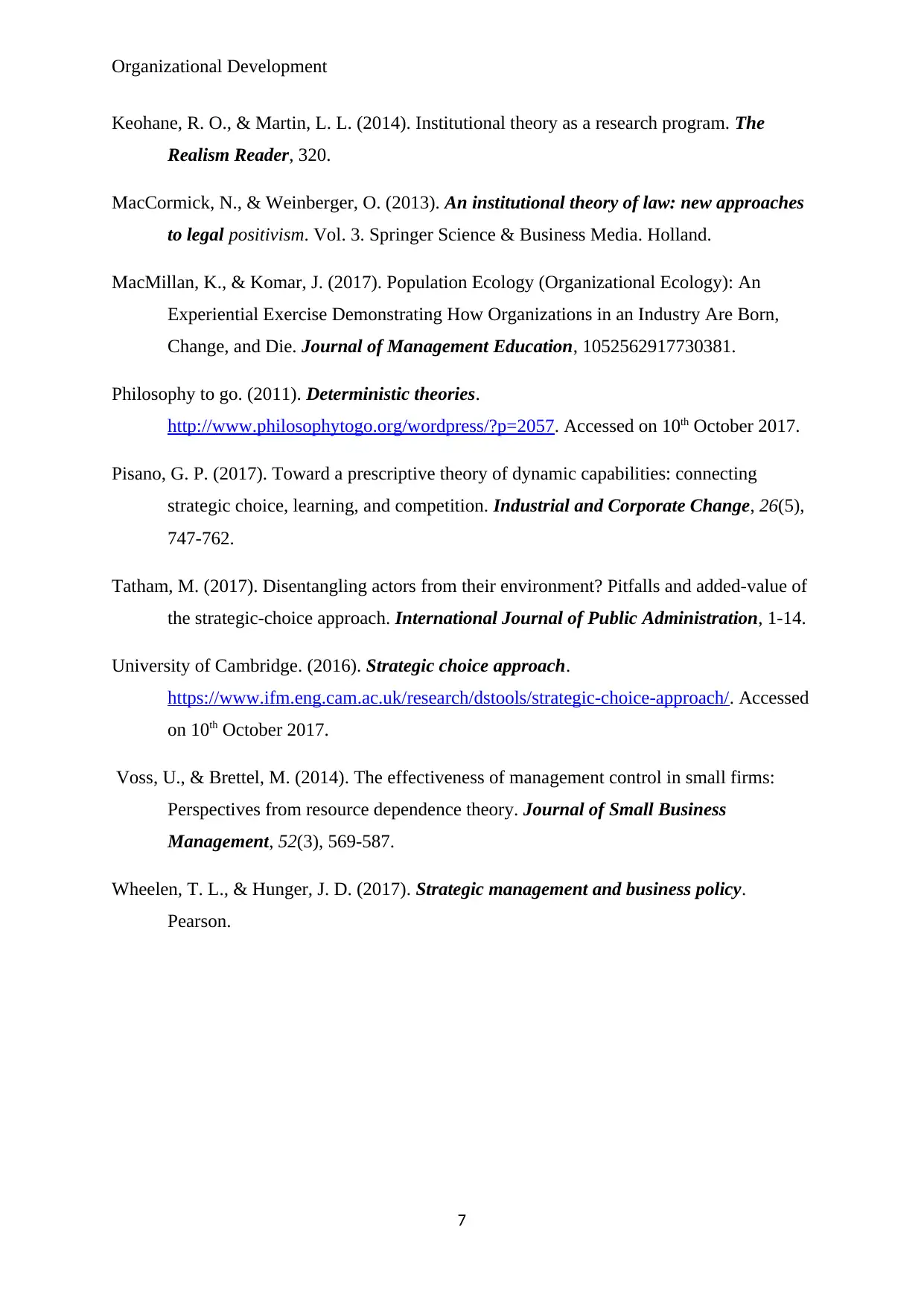
Organizational Development
Keohane, R. O., & Martin, L. L. (2014). Institutional theory as a research program. The
Realism Reader, 320.
MacCormick, N., & Weinberger, O. (2013). An institutional theory of law: new approaches
to legal positivism. Vol. 3. Springer Science & Business Media. Holland.
MacMillan, K., & Komar, J. (2017). Population Ecology (Organizational Ecology): An
Experiential Exercise Demonstrating How Organizations in an Industry Are Born,
Change, and Die. Journal of Management Education, 1052562917730381.
Philosophy to go. (2011). Deterministic theories.
http://www.philosophytogo.org/wordpress/?p=2057. Accessed on 10th October 2017.
Pisano, G. P. (2017). Toward a prescriptive theory of dynamic capabilities: connecting
strategic choice, learning, and competition. Industrial and Corporate Change, 26(5),
747-762.
Tatham, M. (2017). Disentangling actors from their environment? Pitfalls and added-value of
the strategic-choice approach. International Journal of Public Administration, 1-14.
University of Cambridge. (2016). Strategic choice approach.
https://www.ifm.eng.cam.ac.uk/research/dstools/strategic-choice-approach/. Accessed
on 10th October 2017.
Voss, U., & Brettel, M. (2014). The effectiveness of management control in small firms:
Perspectives from resource dependence theory. Journal of Small Business
Management, 52(3), 569-587.
Wheelen, T. L., & Hunger, J. D. (2017). Strategic management and business policy.
Pearson.
7
Keohane, R. O., & Martin, L. L. (2014). Institutional theory as a research program. The
Realism Reader, 320.
MacCormick, N., & Weinberger, O. (2013). An institutional theory of law: new approaches
to legal positivism. Vol. 3. Springer Science & Business Media. Holland.
MacMillan, K., & Komar, J. (2017). Population Ecology (Organizational Ecology): An
Experiential Exercise Demonstrating How Organizations in an Industry Are Born,
Change, and Die. Journal of Management Education, 1052562917730381.
Philosophy to go. (2011). Deterministic theories.
http://www.philosophytogo.org/wordpress/?p=2057. Accessed on 10th October 2017.
Pisano, G. P. (2017). Toward a prescriptive theory of dynamic capabilities: connecting
strategic choice, learning, and competition. Industrial and Corporate Change, 26(5),
747-762.
Tatham, M. (2017). Disentangling actors from their environment? Pitfalls and added-value of
the strategic-choice approach. International Journal of Public Administration, 1-14.
University of Cambridge. (2016). Strategic choice approach.
https://www.ifm.eng.cam.ac.uk/research/dstools/strategic-choice-approach/. Accessed
on 10th October 2017.
Voss, U., & Brettel, M. (2014). The effectiveness of management control in small firms:
Perspectives from resource dependence theory. Journal of Small Business
Management, 52(3), 569-587.
Wheelen, T. L., & Hunger, J. D. (2017). Strategic management and business policy.
Pearson.
7
1 out of 8
Related Documents
Your All-in-One AI-Powered Toolkit for Academic Success.
+13062052269
info@desklib.com
Available 24*7 on WhatsApp / Email
![[object Object]](/_next/static/media/star-bottom.7253800d.svg)
Unlock your academic potential
Copyright © 2020–2025 A2Z Services. All Rights Reserved. Developed and managed by ZUCOL.





